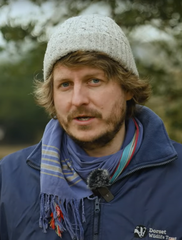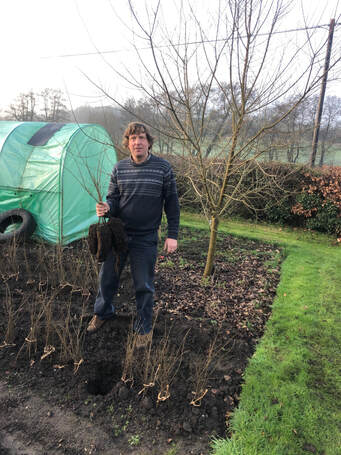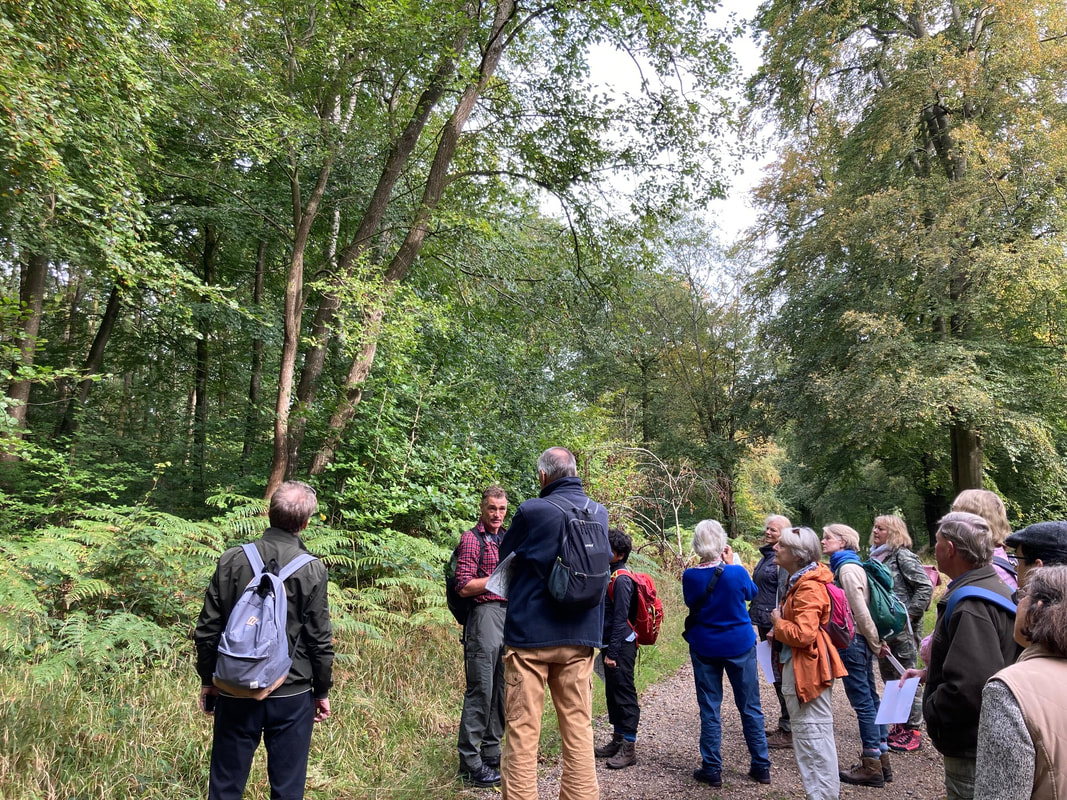|
We are fortunate in southern Wiltshire to have more than our fair share of the county’s ancient woodlands. These are woods that have persisted since at least 1600, which is when maps started to become reasonably reliable so we can track a wood’s history. As they have a long-term continuity of woodland cover and management, such woods are often refuges for wildlife long since lost to the countryside. Some species are so specific to these woods, sometimes because they spread so slowly, that they are used as indicators to help in the identification of ancient sites. New woods planted on open land will never be able to develop the complex and rich biodiversity found in an ancient wood, so a mature woodland planted after the First World War may look splendid in the landscape, but from a wildlife point of view it may have little to offer.
Only 2.5% of the UK is ancient woodland, so it makes those remaining very precious. Although humans will have managed nearly all ancient woods at some time, and in some cases non-native species have been planted, the long-term tree cover allows for deep soils to develop, and complex wildlife communities to thrive. Dead wood, on which scarce fungi and invertebrates rely, can accumulate and archaeological remains such as earth banks and ditches may survive. Just east of Salisbury lies a mosaic of ancient woods, the largest of which is Bentley Wood, which has an interesting history. The area was used to accommodate US troops in the run up to D-Day and then to store vehicles returning after the war. All this had an impact, but woodland continuity was maintained. After the Forestry Commission acquired it in the ‘50s, they filled any gaps created with new planting, until 1983, when the government wanted to sell off many of the Forestry Commission woods. At this point, a local resident stepped in, forming a trust to buy the wood so it could be enjoyed by the public. This was achieved in 1984 and for the past 40 years the woodlands have been carefully managed by The Friends of Bentley Wood for wildlife and public enjoyment. The multiple tracks, rides and paths that criss-cross the wood are a pleasure to walk, and the site is particularly well known for the butterflies and birds found there. Andrew Graham  On Thursday 11th January at 7:30pm in the Victoria Hall on Tisbury High Street, we shall be hearing from Rob Farrington, who has been managing the Wild Woodbury Project from the outset. Rob will describe the work carried out to date, and discuss the prospects for the future and lessons to be drawn from this project for the countryside more widely. As always, our events are free if you’re a member of the Society or under 21, and you’ll be very welcome to come as a guest visitor for the payment of £2. Everyone is welcome at the Tisbury Community Orchard this Sunday 10 December from 10.00am to 12.30pm. Come and find out about pruning fruit trees! Please bring your own refreshments.
Any queries about this free event email: [email protected] Many of us will soon be putting up our Christmas trees for the festive season. Decorated trees are a tradition imported from Germany by the royal family in the 19th Century. For me, the traditional species is Norway Spruce, but that has gradually been replaced by the Nordman Fir, which loses its needles less quickly. They are generally around 10 years old when cut and, with 6-8 million trees sold in Britain each year, most of which are grown here, their plantations cover a considerable land area.
Conifer plantations have had a bad press. There was a drive to create a national reserve of timber, after woodland cover reached an all-time low after the First World War. This resulted in large-scale afforestation of areas where soils were poor, often in ugly rectilinear blocks of single species. While young plantations had a short-lived boost in biodiversity, as the canopy closed, these woodlands often became lifeless. As conifers produce an economic yield up to 6 times faster than deciduous trees, and as the softwood they produce is in high demand for a huge number of uses, we do need these trees. However, management is very different today, large monocultural blocks are a thing of the past. More diverse mixes of species, planting which takes more account of drainage and landform, and the retention or creation of open habitat areas within the forest have become the norm. A number of conifer stands in an existing deciduous wood may increase diversity, while improving commercial viability. Many ancient woods have survived on this basis which might otherwise have been lost as woodland habitat. More forests are now being managed on a continuous cover approach. This seeks to avoid extensive clear felling – taking out all the trees in an area at once – but to create more structurally diverse forests with a greater range of species under a continuous canopy. This avoids sudden changes in habitat conditions, to which wildlife finds it difficult to adapt, reduces erosion and could make the forest more resilient to risks from disease and changes in climate. Obviously, this approach cannot be applied to the Christmas Tree plantations. However, as the trees are spaced to let the light get in, to create the conical trees we love, they can still provide a home for wildlife, especially if pesticides are avoided. It is estimated that artificial trees generate 7 - 20x more carbon than a natural tree. So, if you do have one, it is essential to reuse it as many times as possible. But those of us sticking with natural trees can reduce the carbon footprint by sourcing it locally to keep down the tree miles and by disposing of it thoughtfully. A tree bought from a superstore may have been brought all the way from Scotland (and might have been felled weeks ago and so be ready to drop its needles as soon as you decorate it). The worst option for disposal is to send it to landfill; chipping, burning, or composting all result in lower carbon emissions. Wiltshire County Council will collect old trees from residents with green bins and compost them, or there are charities which collect them for recycling in return for a small donation. Andrew Graham The day was sunny with that slight September chill in the air and we marvelled at the greenness of the trees in Savernake Forest for this time of year. After a wet May and then regular bouts of rain, the trees were showing fewer signs of stress and had kept their leaves longer. Keith Lea had prepared a fascinating day of study and exploration for us as we went off the main paths and visited different sections of the forest.
One of the first tips he shared was the way to differentiate pedunculate from sessile oaks by inspecting the way the leaves and acorns attached to the twigs. Our alliterative aide memoire of sessile-stalk will hopefully stick with us, where the sessile oak has long stalks to its leaves, whereas the pedunculate oak has the leaves forming from barely visible short stalks. We had lively discussions about fungi, having spotted Shaggy parasol, Chicken in the woods, Beefsteak, Earthball and these tiny translucent white parasols perched up high on branches whose name we didn’t know. There were majestic ancient trees to marvel at and glades where trees formed circles round beaten down leaves and mast, or around grassy pastureland in the more open sections. Shifts in the scents of the forest and temperature surges were noticeable as we moved through the different sections. We had a truly immersive day in the life of the forest and Keith was an excellent leader, sharing his knowledge of the trees and wildlife. Much has been said about the need to plant more trees to help to lock up carbon to help address climate change. So, it is particularly upsetting to see recently planted trees that have died during our dry summer and others weakened by the drought shedding their leaves early. This stress is in addition to the natural diseases with which they must contend as a matter of course.
Unfortunately, there are also diseases which, in our global economy, were imported from abroad accidentally. One such is the fungus that causes Ash Dieback. This was first identified in the UK in 2012 although there is evidence that it has been present in Europe for 30 years. It originates in Asia where it does little damage to the local ash species, but our ash - Fraxinus excelsior - has no natural defences to it. Ash is a common species and makes up around 12% of Britain’s broadleaved woodland so its loss will have a significant impact on the landscape. It is estimated that up to 80% of the trees will be killed, although as we are still the early stages of the epidemic, it is hard to judge. Whatever the losses, there will be an impact on those species of wildlife which rely upon ash. The disease can affect trees of all ages although young ones, and those growing in woodlands with high proportions of ash, seem to succumb most quickly. Trees growing in open locations such as streets or in hedgerows seem less susceptible and there appears to be a level of resistance in some trees which, although infected, survive. Local woodland managers have already been clearing ash trees and doubtless we will continue to see this in the years ahead. Those of us old enough to recall the dramatic change to the landscape caused by Dutch Elm Disease in the 1970’s will fear the long-term effect of Ash Dieback but will draw some comfort from the way that other species started to fill the gaps left when the elms were gone. But we must hope that further diseases do not erupt to thwart plans to increase our woodland cover as part of the essential work to lock up more carbon. by Andrew Graham Dr. Peter Inness from the Meteorology Department of Reading University opened this fascinating talk, the last in our 2021/22 series of indoor meetings, with two images of the same patch of woodland near his Oxfordshire home taken two years apart to the day. In the first, the forest floor was carpeted with bluebells; in the second merely a green carpet with a few unopened bluebell buds visible. This was one of several illustrations he used to show how short term changes in weather can impact the natural world, as he sought to distinguish this variability from longer term trends.
In her recent PhD thesis a student at Reading had used data collected by volunteers across the British Isles (recorded on the Natures Calendar website managed by the Woodland Trust) to show that across the UK the mean first flower date for bluebells was 1st of May in 2013, but 8th April in 2017, fully three weeks earlier. Dr Inness was able to explain this difference reflected short term climate impacts, rather than long term trends. Data for bluebell first-flowering dates and temperature records for January to April in successive years show that bluebell flowering dates respond to the weather and temperature conditions during March, February and January, as the plant stems emerge and the flower buds form, rather than during the flowering period itself. And, though invertebrates react rather more rapidly than plants, similar analyses for the first appearance of orange tip butterflies and for blue tits nesting reached similar conclusions. In 2021, by contrast, hawthorn blossom appeared a whole month later than normal, reflecting an abnormally frosty April. Looking at longer term trends and the impact of climate change, however, Dr Inness referred to the paper published recently by the Royal Society. This used records on 406 plant species, some dating from as far back as the 18th century, to show a marked shift that took place in the 1980s. Plants are now emerging on average a whole month earlier each year than seventy years ago. He showed projections prepared by the Meteorological office to indicate that by 2050, in every other year we will experience summer temperatures similar to those we experienced in the very hot year of 2018. And, unless significant reductions in greenhouse gas emissions are achieved globally, these temperatures will be the annual norm by the end of the century. And he also showed projected rainfall maps clearly showing that our winters will be wetter and summers dryer, and warned that individual rainfall events will be 29% stronger. A new UK record for of 316mm rain in a 24 hour period, set as recently as 2009, was surpassed again only six years later in 2015 with a new record of 341mm. All of which suggests that nationally there are considerable tasks and costs ahead to prepare reservoirs and infrastructure to be able to cope. From a wildlife perspective these climate trends are complex and deeply concerning. Dr Inness gave as examples the likely impact on the relatively shallow root systems of beech trees, less well adapted to cope with summer drought conditions than deeper rooted oaks. And the impact on populations of birds such as swallows whose northerly migrations are triggered by seasonal changes in daylight hours. They may arrive at European destinations too late to feed their young on invertebrates maturing earlier as a result of warmer Spring conditions. Troubling as these issues are, the talk was hugely valuable and timely, providing us all with deeper insight into the impact weather and climate have on the natural world around us. by Richard Budden Mid-March into early April is the time of a “blackthorn winter”: a cold spell when the blackthorn is in bloom. This is perhaps because the combination of different strains of the species and the varied micro-climates of their growing locations mean that you can find blackthorn in flower somewhere for more than a month, during which it is likely that there will be at least one cold spell. Or perhaps it is that blackthorn scrub, with its clouds of flowers at their peak, look like the bushes have been covered with snow.
The small white flowers bloom on short stalks from buds along the spines and do so before the leaves appear. En masse, the bloom provides a welcome early source of nectar for insects. These pollinate the flowers, which then develop the distinctive blue-black sloes. The tree grows naturally in scrub, copses, and woodland, and is commonly used to form a cattle-proof hedge. It favours sunny positions, and when left uncut can develop into considerable thickets, such as those in the Oddbrook valley. Mature trees can grow to a height of around 6–7m and live for up to 100 years. The deep brown bark is smooth, and twigs form distinctive, straight, side shoots which develop into thorns. Its trunk and stems form a dense wood which is good for burning and straight stems have been used for walking sticks, including the Irish shillelagh. The foliage provides food for the caterpillars of several moths. The dense thickets provide sheltered nesting sites for birds, which then feast on these caterpillars, and later on the sloes. The scarce brown hairstreak butterfly lays its eggs on blackthorn. This is the largest and brightest of the hairstreak butterflies, the female looking a gorgeous golden colour in flight. However, in common with other hairstreaks, it is quite a small butterfly and notoriously easy to overlook. They spend most of their adult lives perched in the tops of trees, out of sight, lapping honeydew from the leaves. If you are lucky, you might see a female when she descends to lay eggs, nearly always on blackthorn twigs in hedges or bits of sheltered scrub. Our knowledge of the local distribution of this butterfly is improving all the time, due to the efforts of a small number of lepidopterists who tirelessly search suitable locations for these tiny eggs. Correctly identified, these are a reliable indicator of presence, although not necessarily breeding success, but gets around the difficulties of spotting an adult on the wing. The population appears to be spreading westwards from the area north-east of Salisbury. As eggs have been found in the vicinity of Grovely Wood, who knows, they may be present hereabouts without being recorded. Eyes peeled this August/September. by Andrew Graham Members of the Society have been busy on practical projects recently. Before Christmas, in the parish meadow (behind the Nadder Centre) we planted nearly 150 trees. A number of trees and shrubs were planted in 2013 in the sheltered, south-western, bottom corner of the field. These are established now and are beginning to knit together. The new planting will augment these. Species planted included oak, birch, hawthorn, willow, dogwood, buckthorn, hornbeam, beech and crab apple. This diversity of species aims to make it as valuable for wildlife as well as interesting to look at. Most of the trees were relatively small, bare-rooted plants; planted correctly, these have the best chance of rapid establishment. Each is supported with a bamboo cane and spiral guard for protection while a woodchip mulch around the base will help to suppress weeds and retain moisture. We look forward to them bursting into leaf in the spring.
We also took the opportunity to weed amongst the young hedge line between the community orchard and the skatepark, again applying mulch to help their establishment. An ongoing project is to lay the hedge which separates the parish meadow from orchard and skatepark. It will involve cutting away some of the existing growth to make the hedge line thicker and more vigorous in the long term. Laying prompts the existing shrubs in the hedge to send up new growth from the base while still growing from the remaining branches that have been laid. This prevents it getting gappy and top heavy and helps the hedge to develop the width which makes it most valuable to wildlife. In the New Year members were hard at work coppicing in Oysters Coppice Wiltshire Wildlife Trust reserve near Semley. The society will also continue to organise coppicing in the community field in years to come. When coppicing, all the small trees and bushes are cut down to the ground over a defined area. This lets sunlight in and results in a flush of flowering plants for a few years until the cut stumps have regrown and shade returns. Some of the cut material is woven into dead hedges to protect the cut stumps – or stools as they are known – and later more is placed over the stools to prevent deer browsing. Many woodlands in Britain used to be managed as coppices but as the markets for the products that they produced – e.g., hurdles, thatching spars, fence rails and posts – declined so did coppicing, to the detriment of many woods’ wildlife. by Andrew Graham  Congratulations to our chair, Peter Shallcross, Vice Chair of the Nadder Valley Farmer Group, on being short-listed for his disease-resistant elm project in the Conservation Project of the Year category of the 2022 Wiltshire Life Awards. With 6,000 elm trees delivered nationally, Peter’s work over the last five years has made a significant contribution to the re-establishment of elm trees in our landscape and the conservation of species which rely on elms to thrive. |
Photo: Avocets (Izzy Fry)
The headers display photos taken by our members. Do get in touch via the Contact Form if you'd like to submit a photo for selection.
Archives
May 2024
Categories
All
|


 RSS Feed
RSS Feed